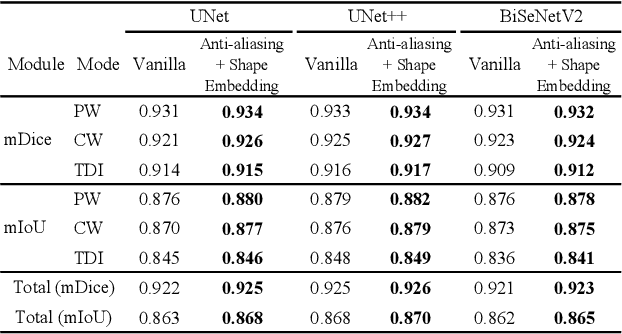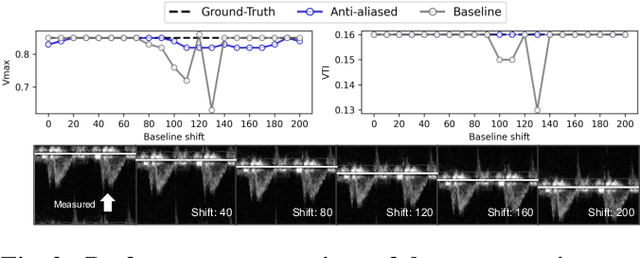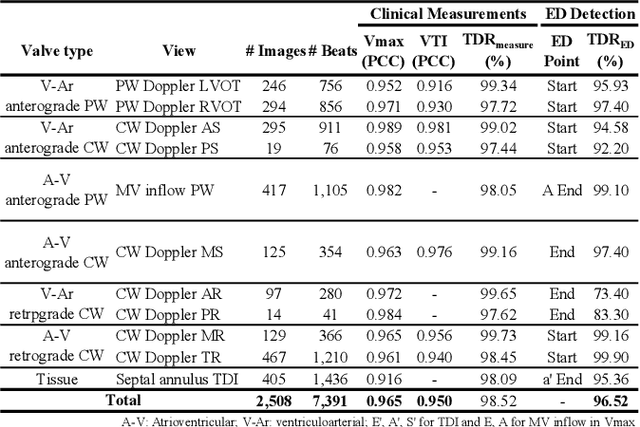Jaeik Jeon
A Unified Approach for Comprehensive Analysis of Various Spectral and Tissue Doppler Echocardiography
Nov 14, 2023



Abstract:Doppler echocardiography offers critical insights into cardiac function and phases by quantifying blood flow velocities and evaluating myocardial motion. However, previous methods for automating Doppler analysis, ranging from initial signal processing techniques to advanced deep learning approaches, have been constrained by their reliance on electrocardiogram (ECG) data and their inability to process Doppler views collectively. We introduce a novel unified framework using a convolutional neural network for comprehensive analysis of spectral and tissue Doppler echocardiography images that combines automatic measurements and end-diastole (ED) detection into a singular method. The network automatically recognizes key features across various Doppler views, with novel Doppler shape embedding and anti-aliasing modules enhancing interpretation and ensuring consistent analysis. Empirical results indicate a consistent outperformance in performance metrics, including dice similarity coefficients (DSC) and intersection over union (IoU). The proposed framework demonstrates strong agreement with clinicians in Doppler automatic measurements and competitive performance in ED detection.
Echocardiographic View Classification with Integrated Out-of-Distribution Detection for Enhanced Automatic Echocardiographic Analysis
Aug 31, 2023Abstract:In the rapidly evolving field of automatic echocardiographic analysis and interpretation, automatic view classification is a critical yet challenging task, owing to the inherent complexity and variability of echocardiographic data. This study presents ECHOcardiography VIew Classification with Out-of-Distribution dEtection (ECHO-VICODE), a novel deep learning-based framework that effectively addresses this challenge by training to classify 31 classes, surpassing previous studies and demonstrating its capacity to handle a wide range of echocardiographic views. Furthermore, ECHO-VICODE incorporates an integrated out-of-distribution (OOD) detection function, leveraging the relative Mahalanobis distance to effectively identify 'near-OOD' instances commonly encountered in echocardiographic data. Through extensive experimentation, we demonstrated the outstanding performance of ECHO-VICODE in terms of view classification and OOD detection, significantly reducing the potential for errors in echocardiographic analyses. This pioneering study significantly advances the domain of automated echocardiography analysis and exhibits promising prospects for substantial applications in extensive clinical research and practice.
Bayesian approaches for Quantifying Clinicians' Variability in Medical Image Quantification
Jul 06, 2022



Abstract:Medical imaging, including MRI, CT, and Ultrasound, plays a vital role in clinical decisions. Accurate segmentation is essential to measure the structure of interest from the image. However, manual segmentation is highly operator-dependent, which leads to high inter and intra-variability of quantitative measurements. In this paper, we explore the feasibility that Bayesian predictive distribution parameterized by deep neural networks can capture the clinicians' inter-intra variability. By exploring and analyzing recently emerged approximate inference schemes, we evaluate whether approximate Bayesian deep learning with the posterior over segmentations can learn inter-intra rater variability both in segmentation and clinical measurements. The experiments are performed with two different imaging modalities: MRI and ultrasound. We empirically demonstrated that Bayesian predictive distribution parameterized by deep neural networks could approximate the clinicians' inter-intra variability. We show a new perspective in analyzing medical images quantitatively by providing clinical measurement uncertainty.
 Add to Chrome
Add to Chrome Add to Firefox
Add to Firefox Add to Edge
Add to Edge